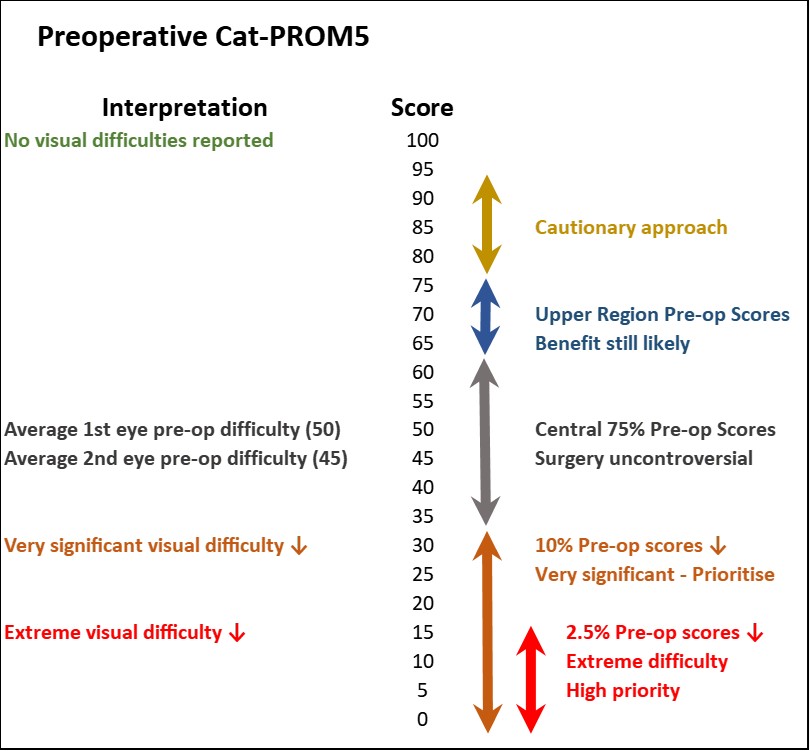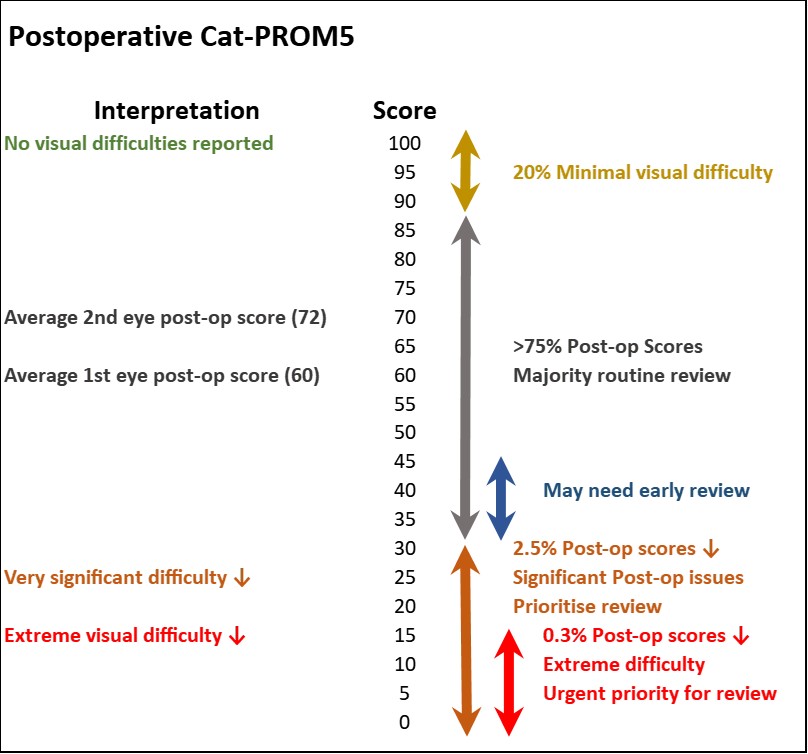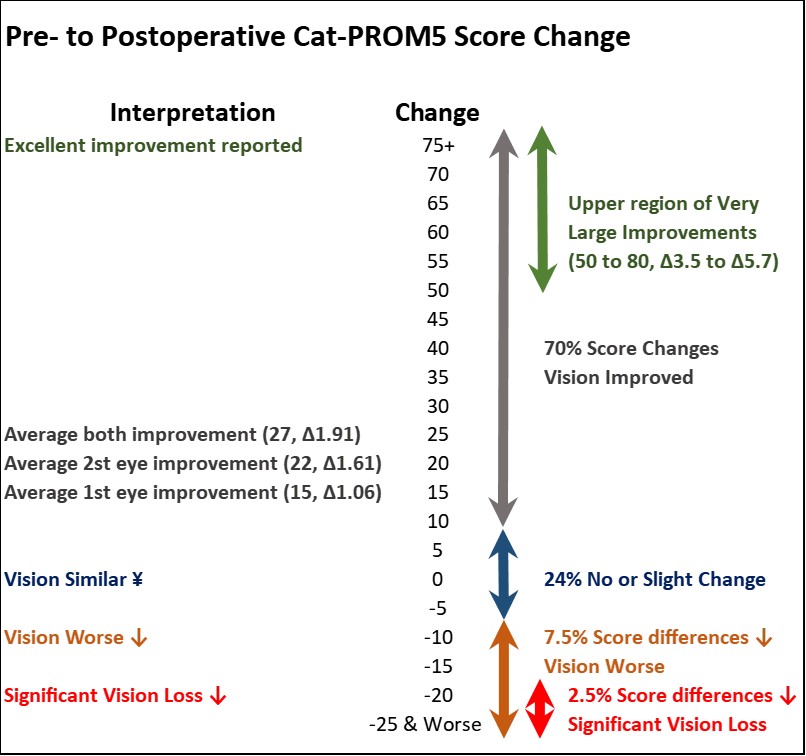Patient reported outcome measures (PROMs) are ideally suited to interventions for symptomatic conditions. The NHS PROMs programme currently collects and reports PROMs for hip and knee surgery.
Cataract causes symptomatic visual difficulties for those affected, with surgery undertaken to relieve those difficulties. Cat-PROM5 has been developed to measure cataract related visual difficulties which adversely impact vision related quality of life, and their relief from surgery. Key features of the Cat-PROM5 questionnaire are its brevity, just five questions, its relevance to people’s every day ‘lived vision’ through use of questions which allow people to map their own problems to the questions, its ability to detect difficulties related to binocularity following a successful first eye operation, and its responsiveness to surgery for both first and second eyes. Overall the questionnaire is psychometrically robust and performs as well or better than the previous ‘best-of-class’ alternative.1,2
The Royal College of Ophthalmologists has chosen Cat-PROM5 as a self-reported patient focused primary outcome for implementation in the National Ophthalmology Database (NOD) National Cataract Audit, and the Welsh PROMs and PREMs Programme has prioritised Cat-PROM5 as their preferred Cataract PROM for implementation across Wales.
Rasch analysis allows for a group of unidimensional questions (each measuring aspects of the same underlying latent trait) to be summarised as a single number on a continuous scale. Rasch units are called ‘Logits’ and are designed such that the average population value is zero, with positive values indicating worse disability and negative values lesser disability. In the context of Cat-PROM5, visual difficulty scores in Logits range from approximately +9 to -9 with the average value for a person with cataract pre-operatively being around zero. Such values do not however provide intuitively easily understood scores, and for convenience the scale has been re-calibrated to a 0 to 100 scale where 0 indicates the worst vision and 100 the best vision.
Cat-PROM5 can be used for a number of interrelated purposes for both individuals and for groups of people. As with all indicators context needs to be taken into account, for example adjustments for people with visually significant non-cataract comorbidities would need to be taken into account. Established risk adjustment methodologies as currently used for existing NOD outcomes reporting would ideally be adopted for Cat-PROM5 outcomes reporting.
- Preoperative average scores can provide useful information about visual difficulties at group level for services and for surgeons. Such scores could for example give an indication of overall levels of self-reported visual difficulty being experienced by people in different geographical locations as a result of unmet need for cataract surgery. At the level of individuals the scores could be useful for prioritisation of surgery for those worst affected by their cataracts.
- Postoperative average scores can provide an overall indicator of surgical success for a service or surgeon with scores for individuals offering opportunities to selectively review patients with less good scores.
- Changes in average scores from pre- to postoperatively can provide an indicator of the overall visual benefits gained by people undergoing surgery at a centre or by a particular surgeon, and scores of individual patients can be used to selectively highlight those who may need further review.
- Where cost effectiveness analysis is deemed important the pre- and postoperative Cat-PROM5 scores can be mapped across to existing health economic indices using models developed specifically with this purpose in mind.3
Interpretation of Cat-PROM5 scores, and changes in scores, allows clinicians and others to gain a sense of the levels of self-reported visual difficulty being experienced by those completing the questionnaire. Using the more intuitive 0 to 100 scale these values can provide a useful guide to understanding the scores. Figures 1, 2 and 3 provide guidance on the meaning of Cat-PROM5 scores for preoperative completions, postoperative completions and score changes from pre- to post operatively (positive change represents visual improvements).
Figure 1: Interpretation of preoperative Cat-PROM5 Scores based on 1,181 questionnaire completions by unselected NHS patients approaching surgery.

Figure 2: Interpretation of postoperative Cat-PROM5 Scores based on 1,181 questionnaire completions by unselected NHS patients following cataract surgery.

Figure 3: Interpretation of pre- to postoperative Cat-PROM5 Score change based on 1,181 questionnaire completions by unselected NHS patients before and after cataract surgery.

References
- Sparrow JM, Grzeda MT, Frost NA, Johnston RL, Liu CSC, Edwards L, et al. Cat-PROM5: a brief psychometrically robust self-report questionnaire instrument for cataract surgery. Eye (Lond). 2018;32(4):796-805.
- Sparrow JM, Grzeda MT, Frost NA, Johnston RL, Liu CSC, Edwards L, et al. Cataract surgery patient-reported outcome measures: a head-to-head comparison of the psychometric performance and patient acceptability of the Cat-PROM5 and Catquest-9SF self-report questionnaires. Eye (Lond). 2018;32(4):788-95.
- Dixon P, Hollingworth W, Sparrow J. Mapping to Quality of Life and Capability Measures in Cataract Surgery Patients: From Cat-PROM5 to EQ-5D-3L, EQ-5D-5L, and ICECAP-O Using Mixture Modelling. MDM Policy Pract. 2020;5(1):2381468320915447.